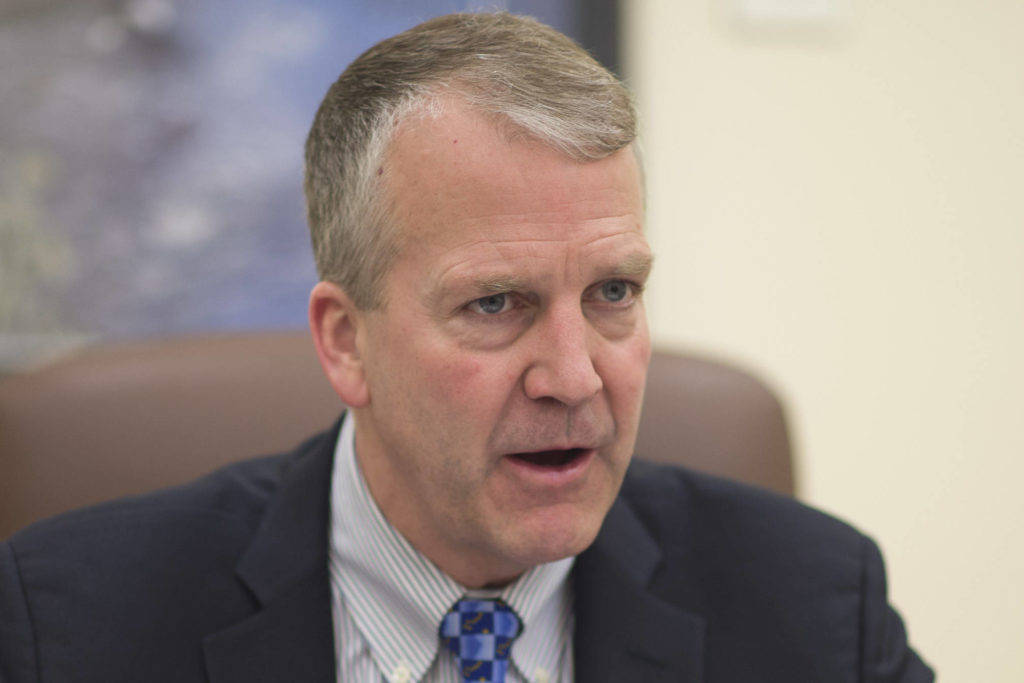Last week, the Commerce Department reported that annualized growth for the second quarter, as measured by the Gross Domestic Product (GDP), was only 2.1 percent. And it revised the fourth quarter of 2018 down to 1.1 percent. President Donald Trump, who during the past year bragged about presiding over the greatest economy in American history, downgraded that superlative to “Not Bad.”
But when Barack Obama was in the White House, U.S. Sen. Dan Sullivan, R-Alaska, said the first figure was unacceptably below the historical average and the second was “pitiful.”
Back then he claimed to be a senate leader on the issue. “The economy isn’t growing,” he said in October 2015. “It’s the worst recovery in U.S. history. The average GDP growth in the United States from 1790 to 2014 is about 3.7 percent. That’s what’s made us great. You don’t have great universities, you don’t have a great military, you don’t have great manufacturing unless you are growing the economy on a regular basis.”
He made a similar argument before an audience at the Alaska Miners Association annual conference last November. That time though he argued the Tax Cuts and Jobs Act of 2017 would help the economy grow between 3.0 and 3.5 percent, which in turn would generate enough new tax revenue to lower the federal deficit.
So far, he’s wrong on both counts. And he just voted on a budget bill that will add $320 billion to the deficit.
But enough of the numbers. Because they mean nothing without context.
For Obama’s record, we have to consider the fact his presidency began during the worse economic downturn since the Great Depression. And during six of his years in office, he had little to no cooperation from the Republican majority in the House of Representatives.
The record before 1930 is questionable too. GDP hadn’t yet been defined. So how did researchers who estimated growth during those years account for slavery or child labor? Should we feel proud that those horrible practices contributed to any economic growth at all?
The nation’s real economic history before and after 1930 is more like a roller coaster than the steady ride to greatness. And if we want to use GDP as the authoritative measure of a president’s economic agenda, then Franklin D. Roosevelt gave us the greatest economy. And his policies are very different than anything Sullivan would ever support.
Like Obama, Roosevelt took office when the economy was going it reverse. His New Deal spurred growth from 9.8 to 12.9 percent, suggesting that the massive expansion of government spending, largely for public works projects, and raising taxes to pay for it all were smart. And that placing stricter regulations on financial institutions didn’t harm the economy.
Growth hit 18 percent during World War II. But like slavery and child labor, war is not an indicator of a healthy society. A bad war like the one we fought in Vietnam should disqualify the 5.0 percent growth under Lyndon Johnson. And turn the 1970 recession under Richard Nixon into an economic disgrace.
Bill Clinton and Ronald Reagan grew the economy at just over the historical average. Clinton did it with the smallest increase in the deficit and lowest defense spending in half a century. Reagan, on the other hand, cut taxes, ramped up defense spending without a war and oversaw the greatest deficit increase.
Take presidential politics out of the story and consider how manufacturing has been replaced by the financial sector as the largest player in the economy. Between 1950 and the present, banking, insurance, real estate, rental and leasing, all of which produce little more than paper wealth, rose from 10 to 20 percent of our total GDP. Meanwhile, manufacturing fell from a quarter to just 12 percent.
And today, when many are arguing government has grown out of control, its component of the GDP is 13 percent, just a point higher than in 1950.
The bottom lines are America’s economic real history is a mixed bag that doesn’t necessarily support the philosophy of either party; and it takes more than good GDP numbers to make a nation great. Which is why it’s unwise for any politician to reduce it to a trivial story for the sake of increasing or cutting government spending, or setting new tax policy.
• My Turns and Letters to the Editor represent the view of the author, not the view of the Juneau Empire.

